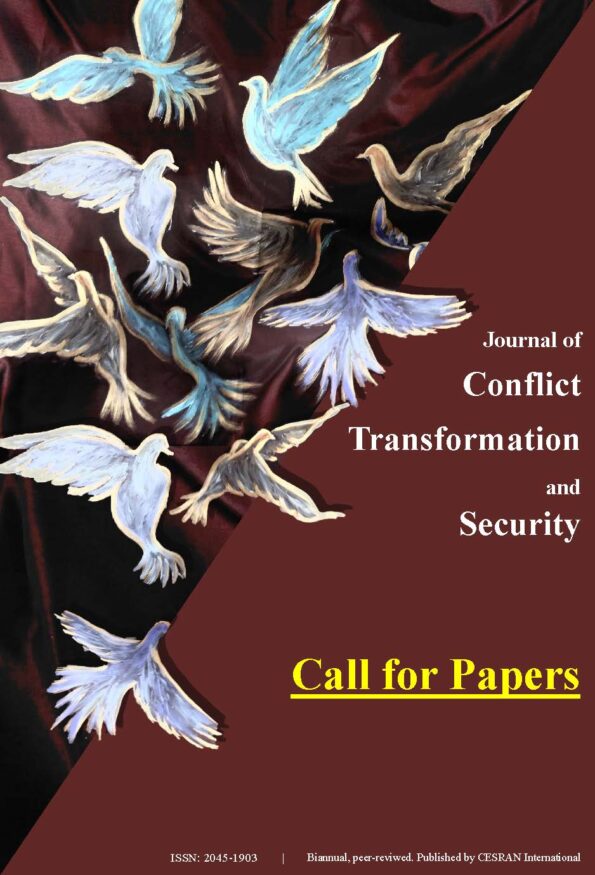
Tugche Veys
Research Fellow
Introduction
Throughout the past couple of decades, a growing number of scholars have investigated the relationship between military forces and sexual violence. Specifically, the “rape as a weapon of war” frame gained importance in the twentieth century, predominantly with the cases of Rwanda, Bosnia and Herzegovina, and the Democratic Republic of Congo (DRC). This narrative argues that rape is often state-sponsored, often strategically employed by the military, where the aim is to inflict pain and suffering on the enemy side (Crawford, 2017, p. 34). It is intentionally used as a tactic and practice for many purposes: demoralizing and humiliating the public, rewarding the soldiers, a key component of ethnic cleansing and showing dominance and power (Crawford, 2017, p. 34). While some argue that rape occurs because regulation and oversight mechanisms weaken during wartime (Wood, 2006, p. 321), others argue that rape is a tool and has a much wider agenda when it is employed systematically (Varrasso, 2012, p. 46). Feminist scholars argue the latter, which is the main focus of this paper. According to the literature, the issue of sexual violence holds great importance while looking at civil-military relations. Therefore, this paper will try to introduce a different perspective on civil-military relations by discussing the influence of the “rape as a weapon of war” framework. There will be brief examples of the countries mentioned above in the analysis to better understand the topic.
Power
Rape in war is both a sensitive and gendered topic. Brownmiller (1975) argues that when a soldier rapes a woman from the enemy side, he shows that he is more powerful and dominant than the men on the defeated side. Especially in the context of marriage, this destroys the dignity and honour of the losing side’s men, being that raped woman’s body becomes a “ceremonial battlefield” (p. 31). Moreover, she argues that sexual violence is exercised to mentally and physically break the enemy (p. 31). As a symbol of brutality, rape makes it possible to see which side wins and which side loses. Thus, women become rewarding figures that can be used by victorious soldiers. In Rwanda, there were more than two hundred thousand women rape and sexual torture victims, while in Bosnia, there were almost sixty thousand women and girls impregnated and forcedly kept in rape camps until they could not get an abortion (Crawford, 2017, p. 47). For instance, after a Serbian soldier raped a Bosnian woman, he told her that this Chetnik boy would kill Muslims when he grew up (Bassiouni, 1996, p. 18). In this sense, rape was a manifestation of the power, dominance, and ethnic superiority of a certain group. Especially in the Bosnian case, rape became the heart of conducting ethnic cleansing.
Varrasso (2012) argues that the impregnation of women through the rape of the combatant forces has medical as well as social consequences. An eminent example of this would be the DRC. Armed forces who rape the civilian population of the enemy side deliberately attempt to infect their victims with HIV/AIDS to demoralize and terrorize the public (p. 47). As a result, passing on these viruses, combatants are therefore likely to infect the fetuses as well. From the cultural aspect, these babies are considered half-blooded and therefore seen as unrepresentative of their cultural group (p. 47). In turn, through rape, the winning side is able to push the victims out of their social community by demonstrating their dominance. Again, Varrasso’s point is highly relevant in the case of DRC. In her research, she mentions the words of a Congolese soldier. The soldier states that they must rape women to defeat the enemy because that is what war means (p. 49). In sum, rape was regarded by someone as a driving force for war success and an essential component in both cases, as stated above.
In conclusion, rape by state armed forces is influential in performing strength. It is the violent nature of the conflict that makes the issue of rape crucial to discuss. Sexual violence is not collateral damage but rather an effective tool for certain ethnic groups and actors to establish superiority in war.
Political strategy
In wartime, the intensity of rape varies among wars. However, if there is evidence that mass rape is exercised, it is questionable how these atrocities occur. One key reason is that rape is ordered, tolerated, and strategic. According to MacKinnon (2006), rape is “systematic and group-based” (p. 22). He argues that rape is a practice employed and exercised deliberately by the state armed actors. He further states that rape does not occur randomly or individually but instead collectively. It is a known issue, and commanders tolerate it to achieve their political goals (Schneider, 2015, p. 1342). In other words, there is a political agenda behind rape. Consequently, it also makes the issue of state involvement in wartime rape problematic and controversial under international law, where sexual violence is considered a crime. Strikingly, Cohen et al. (2013), in their United Nations Special Report, find evidence that armed state actors sexually violate civilians more than rebel or insurgent groups (p. 3). Concerning military operations, states use rape to torture their captives and civilian population for their interests (p. 4). This begs the following question: how do states act in war? Even though today’s rule-based international order claims that liberal norms and institutions are predominantly in place, the literature on weaponizing rape in war often shows that states are realist actors when it comes to war. State-sponsored sexual violence challenges the liberal order the world accompanies today. This rubric can be essential for further research in examining state behaviour from the feminist perspective by taking sexual violence into account.
Moreover, feminist scholars such as Enloe (2014) argue that there are conditions that militarise rape. These are recreational rape, national security rape, and systematic mass rape (p. 111). Recreational rape implies that if soldiers are not provided with prostitution, they will be likely to rape civilians. This logic aligns with the Japanese “comfort women” policy during the Second World War, where the Japanese army forced women and girls to be sex slaves who were entitled to fulfil soldiers’ sexual desires (Bruheim & Glaab, 2018, p. 16). Therefore, Enloe (2014) argues that in the absence of women, the soldiers can become recreational rapers. In light of the comfort women policy, this is simply to say that military engagement in sexual violence is a necessary evil. Secondly, national security rape means the governmental use of rape to humiliate, degrade and punish women who do not want to obey. This is a way of showing patriarchy and masculinity, which can be considered under the section above (power). Lastly, systematic mass rape entails hostility towards the other ethnic group. Rape is used as an instrument to oppress a certain group and give the message that those men were unable to protect their women. Systematic mass rape is merely based on destroying the identity and symbolic norms of that distinct group by the perpetrator group. To conclude, these three conditions provide an insightful analysis of the militarization of rape and how state armed actors play a huge role. Yet, none of these conditions legitimizes rape or sexual violence.
Rape becomes an international security issue when it is used as a weapon of war (Crawford, 2017, p. 162). Even though the military is an institution where men learn how to be masculine, this does not mean they are free to carry out sexual violence on civilians to satisfy their needs. Regarding this point, Sharlach (2010) presents three indications of how rapes in Bosnia gained international status as being “systematic and planned” (p. 97). First, rape was performed in places that did not have links to each other, and identical elements were present in these places. Second, sexual violence happens in different areas of the country synchronically. Third, rape camps were established by (predominantly) Serbian armed forces. The last segment of Sharlach’s point is remarkable because the establishment of rape camps shows that military leaders do promote this violence and tolerate it. Therefore, overall, the literature on weaponizing wartime rape shows that there are political and strategic factors and contributing factors to this crime. Scholars may differ on their reasonings and explanations, yet they agree on a certain assumption that the framework is built upon the politicization of sexual violence.
Group behaviour and military unity
A military environment is a social place where commanders communicate with the soldiers through the chain of command. The hierarchical structure of the military, thus, entitles the soldiers to obey their commanders’ orders. Therefore, while delivering these orders, soldiers engage in activities regardless of how violent they are. Because if they are unable or unwilling to do so, they become socially excluded from the military. According to Bassiouni (1996), this is depicted in the case of Bosnia where the Serbian militia forced a young (Serbian) boy to rape a woman in front of her family, and the boy could not perform the act because he was not sober enough to do it (p. 18). As a consequence, the militia members made fun of the boy and disregarded him in the forces (p. 18). Bassiouni’s point favours that soldiers become more inclined to perform these actions just because they do not want to be left out of their unit. Concerning this group behaviour, Wood (2006) provides a valuable finding where she discusses variations of sexual violence by providing case studies. She finds that when rape is supported by the top chain of command, it strengthens military solitary among the soldiers (p. 327). As the fighting power of the military increases, success in war becomes more likely. She further asserts that even the commanders themselves often are the perpetrators of these acts (p. 316). Briefly, while Bassiouni argues that a group bond is established from the fear and diffidence of members to end up being outsiders in the military, Wood states that there is a creation of unity through conducting sexual violence. Yet, their evidence converges on the assumption that rape is a way of group bonding and team building in civil-military relations.
Conclusions and Implications
This paper offers a substantive ground for understanding how rape as a weapon of war impacts civil-military relations. The paper addresses several scholars, mostly from the feminist perspective, as a different viewpoint of civil-military relations. The main motive is to fill the gap in the conventional wisdom where rape is seen as collateral damage and an unwanted consequence of wars. Rather, sexual violence can be a tool, practice, and strategy that influences peoples’ minds. It can be used to demonstrate the power and superiority of a certain state or an ethnic population, a form of political strategy, and finally, a way of unification towards personal goals. The literature shows that states may get involved in sexual violence through established channels, mainly being military/paramilitary groups.
Although rape is a sensitive issue regardless of gender, the existing literature does not necessarily touch upon the male victims. The understanding of rape and its weaponization is built upon taking women and children as vulnerable objects that need to be protected. Though there is a large amount of literature on female victims, further research might also focus on male victims to provide a masculine perspective on the topic. By comparing the two narratives, scholars can draw conclusions that may help to build an overall discourse on wartime rape. Regarding the documentation of rape cases, scholars touch upon the difficulties of finding evidence and support for these atrocities. Since there is no clear measurement for rape in statistical analysis, limitations arise from the inaccessibility of data. All in all, this paper is constructive with the inclusion of different components, aiming to examine the logic of rape as a weapon of war narrative and how it relates to civil-military relations.
References
Bassiouni, M. (1996). Sexual Violence: An Invisible Weapon of War in the Former Yugoslavia. Chicago, International Human Rights Law Institute.
Brownmiller, S. (1975). Against our will: Men, women and rape. London: Secker and Warburg.
Bruheim, A., & Glaab, K. (2018). Sexual Violence as a Weapon in War. Norwegian University of Life Sciences.
Cohen, D. K., Green & Wood, E. J. (2013). Wartime Sexual Violence. Misconceptions, Implications, and Ways Forward. United States Institute of Peace Special Report 323, February.
Crawford, K. F. (2017). Wartime Sexual Violence: From Silence to Condemnation of a Weapon of War. Washington: Georgetown University Press.
Enloe, C. (2014). Bananas, Beaches and Bases: Making Feminist Sense of International Politics (2nd ed.). California: University of California Press.
MacKinnon, C. (2006). Are Women Human? And Other International Dialogues. Cambridge, MA: Harvard University Press.
Schneider, G., Banholzer, L., & Albarracin, L. (2015). Ordered Rape: A Principal-Agent Analysis of Wartime Sexual Violence in DR Congo. Violence Against Women, 21(11), 1341-1363.
Sharlach, L. (2000). Rape as Genocide: Bangladesh, the Former Yugoslavia, and Rwanda. New Political Science, 22(1), 89-102.
Varrasso, B. (2012). Sexual violence perpetrated against women in war. Perspective Youth Journal, 6, 46-51.
Wood, E. (2006). Variation in sexual violence during war. Politics & Society, 34(3), 307-341.



